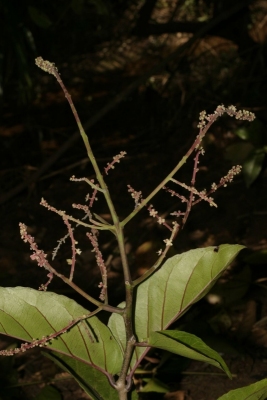Homalium letestui
Pellegr.
Salicaceae
Homalium dolichophyllum Gilg
Homalium skirlii Gilg ex Engl.
Common Name:
General Information
Homalium letestui is an evergreen tree; it can grow up to 27 metres tall, occasionally to 33 metres. The long, straight, slender bole can be 30 - 60cm in diameter[
316- Title
- Tropical Timbers of the World. Ag. Handbook No. 607.
- Publication
-
- Author
- Chudnoff. Martin.
- Publisher
- USDA Forest Service. Wisconsin.
- Year
- 1984
- ISBN
-
- Description
- Terse details on the properties of the wood of almost 400 species of trees from the Tropics.
,
332- Title
- The Useful Plants of West Tropical Africa.
- Publication
-
- Author
- Burkil. H. M.
- Publisher
- Royal Botanic Gardens; Kew.
- Year
- 1985 - 2004
- ISBN
-
- Description
- Brief descriptions and details of the uses of over 4,000 plants. A superb, if terse, resource, it is also available electronically on the Web - see http://www.aluka.org/
].
The tree is harvested from the wild mainly as a source of a good quality timber, which is sometimes exported. It has magnificent clusters of rose-coloured flowers, the fruits are also showy and the young leaf-flush is red before turning green. The tree is thus attractive and worthy of cultivation[
332- Title
- The Useful Plants of West Tropical Africa.
- Publication
-
- Author
- Burkil. H. M.
- Publisher
- Royal Botanic Gardens; Kew.
- Year
- 1985 - 2004
- ISBN
-
- Description
- Brief descriptions and details of the uses of over 4,000 plants. A superb, if terse, resource, it is also available electronically on the Web - see http://www.aluka.org/
].
Known Hazards
None known
Botanical References
Range
West tropical Africa - Senegal to Nigeria and Cameroon, south to northern Angola and western DR Congo.
Habitat
Dense rain-forest and transition forest to semi-deciduous forest; gallery forest; mixed and secondary forest, preferring proximity to running water; at elevations from 100 - 880 metres[
328- Title
- African Flowering Plants Database
- Publication
-
- Author
-
- Website
- http://www.ville-ge.ch/musinfo/bd/cjb/africa/recherche.php
- Publisher
- Conservatoire et Jardin Botaniques.
- Year
- 0
- ISBN
-
- Description
- Contains information on over 150,000 plant names (including synonyms) giving a description and habitat, plus a distribution map.
,
332- Title
- The Useful Plants of West Tropical Africa.
- Publication
-
- Author
- Burkil. H. M.
- Publisher
- Royal Botanic Gardens; Kew.
- Year
- 1985 - 2004
- ISBN
-
- Description
- Brief descriptions and details of the uses of over 4,000 plants. A superb, if terse, resource, it is also available electronically on the Web - see http://www.aluka.org/
].
Properties
| Medicinal Rating |      |
| Other Uses Rating |      |
| Habit | Evergreen Tree |
| Height | 22.00 m |
| Cultivation Status | Ornamental, Wild |
Cultivation Details
Not known
Edible Uses
None known
Medicinal
The sap from the bark is used in enemas for the treatment of generalised oedemas while lees from the bark are rubbed over the area[
332- Title
- The Useful Plants of West Tropical Africa.
- Publication
-
- Author
- Burkil. H. M.
- Publisher
- Royal Botanic Gardens; Kew.
- Year
- 1985 - 2004
- ISBN
-
- Description
- Brief descriptions and details of the uses of over 4,000 plants. A superb, if terse, resource, it is also available electronically on the Web - see http://www.aluka.org/
].
A bark-decoction, combined with other medicinal plants, is taken by draught for orchitis, and bark-scrapings enter a prescription given to a newly-delivered woman[
332- Title
- The Useful Plants of West Tropical Africa.
- Publication
-
- Author
- Burkil. H. M.
- Publisher
- Royal Botanic Gardens; Kew.
- Year
- 1985 - 2004
- ISBN
-
- Description
- Brief descriptions and details of the uses of over 4,000 plants. A superb, if terse, resource, it is also available electronically on the Web - see http://www.aluka.org/
].
Other Uses
The heartwood is light brown or yellowish-white, sometimes with darker stripes; it is not clearly demarcated from the sapwood. The texture is fine; the grain straight or interlocked; lustre dull The wood is hard, heavy, moderately durable, being fairly resistant to marine borer attack. Because of its strength and hardness, the wood is commonly used for house-posts, carpentry, and is cut for small timbers and boards[
316- Title
- Tropical Timbers of the World. Ag. Handbook No. 607.
- Publication
-
- Author
- Chudnoff. Martin.
- Publisher
- USDA Forest Service. Wisconsin.
- Year
- 1984
- ISBN
-
- Description
- Terse details on the properties of the wood of almost 400 species of trees from the Tropics.
,
332- Title
- The Useful Plants of West Tropical Africa.
- Publication
-
- Author
- Burkil. H. M.
- Publisher
- Royal Botanic Gardens; Kew.
- Year
- 1985 - 2004
- ISBN
-
- Description
- Brief descriptions and details of the uses of over 4,000 plants. A superb, if terse, resource, it is also available electronically on the Web - see http://www.aluka.org/
]. It is suitable for heavy construction, flooring, boatbuilding, railroad crossties, poles and piles[
316- Title
- Tropical Timbers of the World. Ag. Handbook No. 607.
- Publication
-
- Author
- Chudnoff. Martin.
- Publisher
- USDA Forest Service. Wisconsin.
- Year
- 1984
- ISBN
-
- Description
- Terse details on the properties of the wood of almost 400 species of trees from the Tropics.
].
Propagation
Seed -
If you have any useful information about this plant, please leave a comment. Comments have to be approved before they are shown here.




 Useful Tropical Plants Database 2014 by
Ken Fern,
web interface by
Ajna Fern
with help from
Richard Morris.
Useful Tropical Plants Database 2014 by
Ken Fern,
web interface by
Ajna Fern
with help from
Richard Morris.